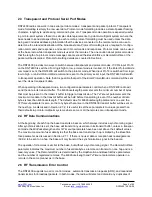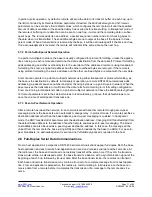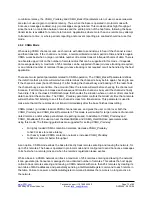
www.RFM.com
Technical s1.678.684.2000
Page 22 of 82
©2009 by RF Monolithics, Inc.
E-mail:
DNT2400 - 08/18/09
•
The remote will remain awake while it still has any ARQ attempts left for a queued transmit
packet of any type.
•
The remote will remain awake while it is has serial characters in its buffer left to transmit to its lo-
cal host.
Sleep functions are controlled by the following registers (see Section 4.2):
•
SleepMode - enables/disables sleep mode.
•
WakeResponseTime - sets the amount of time that a remote will wait for a
response after sending an I/O report.
•
WakeLinkTimeout - sets the maximum time that a remote will spend trying
to acquire it base before giving up.
Sleep is also affected by the following registers associated with I/O reporting: IO_ReportTrigger,
IO_ReportInterval, ADC_SampleIntvl, and GPIO_EdgeTrigger. The following table indicates how the
status and control pins function on sleeping remotes (see Table 2.12.1):
Pin
Awake
Sleep
/HOST_RTS
Normal operation
high impedance
/HOST_CTS
Normal operation
0 V
/DCD
Normal operation
0 V
ACT
3 V
0 V
DIVERSITY
Normal operation
0 V
RADIO_TXD Normal
operation
Hi-Z
RADIO_RXD
Normal operation
0 V
Table 2.12.1
Note that the ACT pin may be used by a local host to detect when a sleeping remote is awake. The
behavior of the GPIOs during sleep is governed by the GPIO_ SleepMode, GPIO_SleepDir, and
GPIO_SleepState configuration registers. Refer to the register definitions in Section 4.2.
2.13 Encryption
The DNT2400 supports 128-bit AES encryption of data and configuration packets. Encryption is enabled
by setting the EncryptionKey register to a value other than a string of NULL (0x00) bytes. A remote with-
out encryption enabled cannot link to an encrypted base, and an encrypted remote will not attempt to link
to an unencrypted base. A remote's encryption key must match that of the base before it can link. The
EncryptionKey register can be set over the air so it can be changed periodically if desired. Once an
encryption key has been entered, it can be changed but it cannot be read back.
2.14 Synchronizing Co-located Bases
The EX_SYNC input (Pin 15) on the DNT2400 allows co-located bases to synchronize their transmissions
so they all transmit at the same time. This prevents the situation where one base is transmitting while
another nearby base is trying to hear a distant remote. Even though the base radios may be on different






























